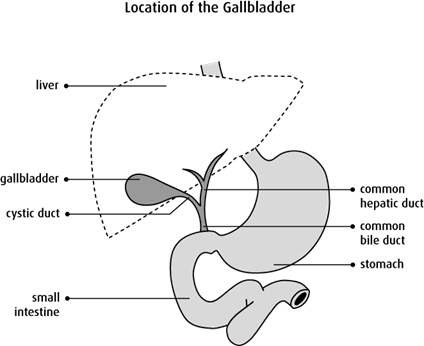The gallbladder
The gallbladder is part of the digestive system. It is a small, pear-shaped organ on the right side of the body, under the right lobe of the liver.
The body can function without the gallbladder. If doctors need to remove it because of disease, there are no serious long-term effects and the body can still digest food.

Structure
The gallbladder is about 7.5–10 cm (3–4 in) long and about 2.5 cm (1 in) wide.
The gallbladder is made up of layers of tissue:
- mucosa – the inner layer of epithelial cells (epithelium) and lamina propria (loose connective tissue)
- a muscular layer – a layer of smooth muscle
- perimuscular layer – connective tissue that covers the muscular layer
- serosa – the outer covering of the gallbladder
The gallbladder, liver and small intestine are connected by a series of thin tubes or ducts.
- The common hepatic duct drains bile from the liver through the left and right hepatic ducts.
- The cystic duct joins the gallbladder to the common bile duct.
- The common bile duct is where the hepatic and cystic ducts meet and connect to the small intestine.
The gallbladder and bile ducts are also called the biliary system or biliary tract.
Function
The gallbladder stores and concentrates bile, a yellowish-green fluid made by the liver. Bile helps the body digest fats. Bile is mainly made up of:
- bile salts
- bile pigments (such as bilirubin)
- cholesterol
- water
The liver releases bile into the hepatic duct. If the bile is not needed for digestion, it flows into the cystic duct and then into the gallbladder, where it is stored. The gallbladder can store about 40–70 mL (8–14 tsp) of bile. The gallbladder absorbs water from the bile, making it more concentrated. When bile is needed for digestion after a meal, the gallbladder contracts and releases it into the cystic duct. The bile then flows into the common bile duct and is emptied into the small intestine, where it breaks down fats.
